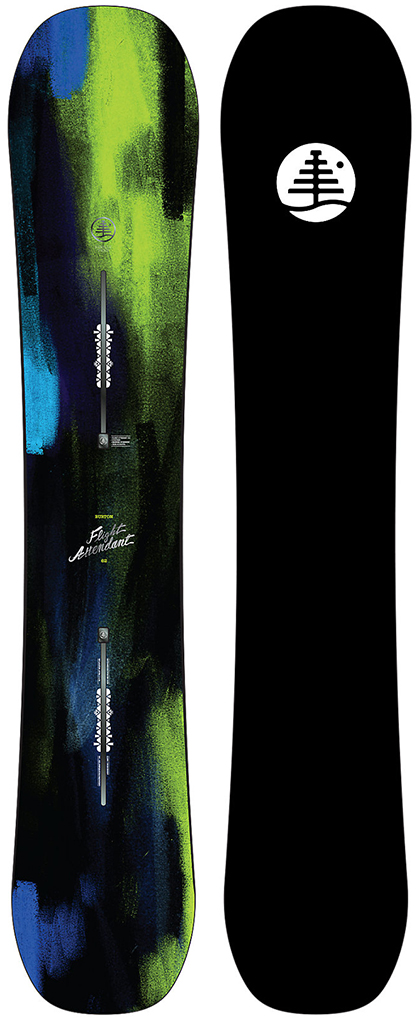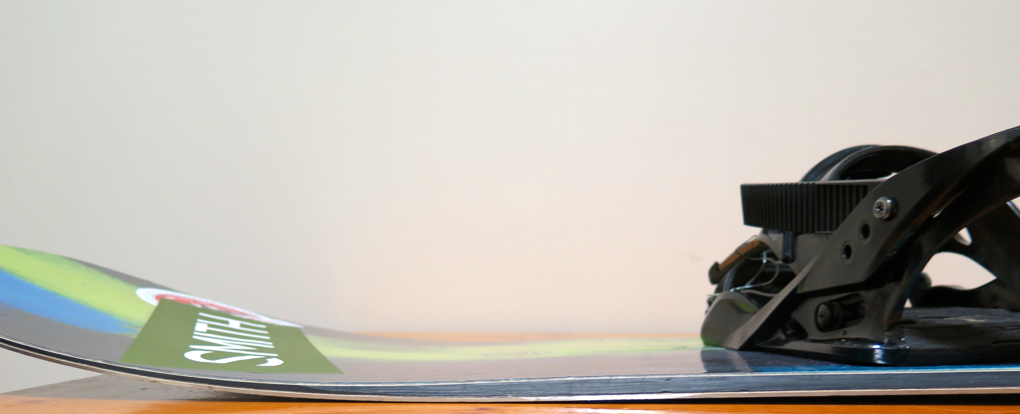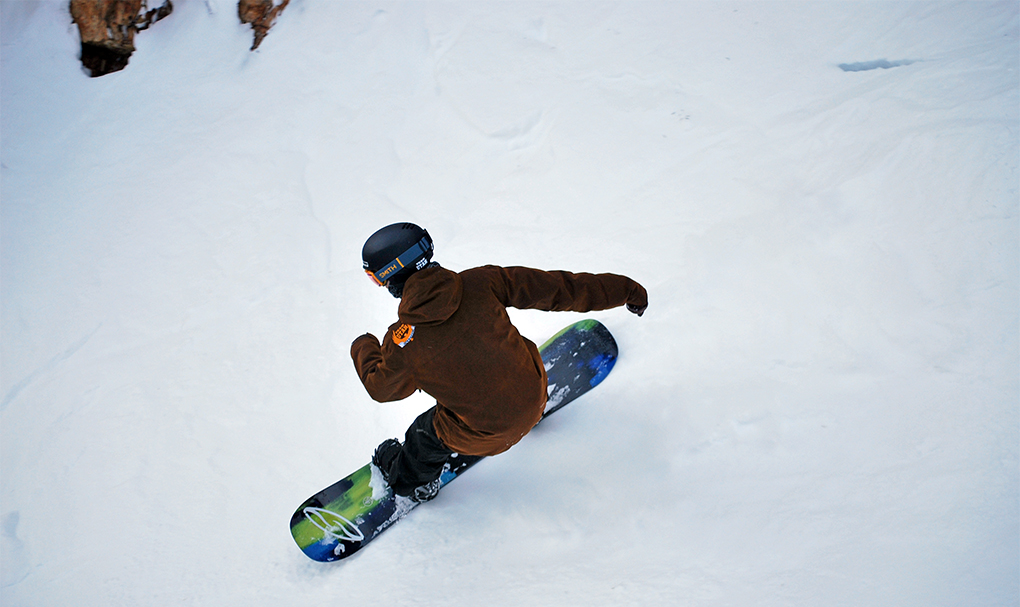
2020-2021 Burton Flight Attendant, 162cm
MSRP: $500
Dimensions and Specs:
- Nose Width: 303.4 mm
- Waist Width: 254 mm
- Tail Width: 293.4 mm
- Sidecut Radius: 7.8 m
- Ref. Stance: 560 mm (22.04 inches), 35mm set-back
- Weight Range: 75-93 kg (165-205 lbs)
Features:
- Balanced Freeride Geometry
- Sintered WFO Base
- FSC certified sustainable wood core (thumbs up for sustainable manufacturing)
- Recycled PET Topsheet: made of 50% plastic bottles (Blister thumbs up)
- Triaxial Fiberglass (3 layers of fiberglass)
- The Channel: Burton’s own mounting system utilizing one continuous channel rather than set inserts
- Squeezebox (variable core thickness from tip to tail to maximize response)
Reviewer Info: 6’2′, 165 lbs
Stance: 23” wide; 15° front, -12° rear; forward 0.5 from reference mark
Boots / Bindings: Burton SLX (size 10) / 2012 Burton Cartel (size M)
Test Locations: Snowbird, Wasatch Backcountry, UT.
Days Tested: 20+
[Note: Our review was conducted on the 14/15 Flight Attendant, which was not changed for 15/16, 16/17, 17/18, 18/19, 19/20, or 20/21, apart from graphics.]
New for the 2014-2015 season, the Flight Attendant was designed with serious input from backcountry freestyle legend Nicolas Müller, and is billed as “a terrain-slaying alternative to more traditional twin shapes.” More specifically, Burton says the Flight Attendant is designed to ride like a twin on hardpack and serve as a more directional, freeride board in powder and chop.
That’s a tall order, and the Flight Attendant’s design and shape is about as radical as Burton’s claims about it. I looked at plenty of snowboards at SIA 2014, but none of them caught my attention quite like when Dave Downing introduced me to the strange-looking Flight Attendant.
Design & Shape
The Flight Attendant is similar to a blunt-tipped jib board in that it has a twin sidecut and traditional camber between and under the feet. However, the board is unlike any I’ve seen in that its nose has effectively been stretched out and widened, creating a dramatic, rockered profile that begins about 5cm in front of the front binding. (Burton says that the rocker begins underfoot, but it’s clear to me when riding and looking at the board that it begins farther forward). The stance on the Flight Attendant is set back 35mm, so it’s aligned with the board’s twin sidecut and traditional camber (Burton calls this their “Balanced Freeride Geometry.”)

The Flight Attendant’s nose is 303.4mm wide at its widest point, which is ahead of the front edge contact point, and the tail of the board is 10mm narrower at its widest point. So while the board has a conventional, symmetrical twin design in terms of its sidecut and effective edge, its overall dimensions give it a directional pin-tail / tapered shape, too.
I’ve enjoyed several hybrid, rocker/camber boards in the past (like the Rossignol Angus, Rossignol Jibsaw, and Burton Antler), but I’ve always missed the stability and power of a board with full camber between the feet. In this way, I hoped the Flight Attendant could provide close to a full-camber experience while its softer, rockered nose would also make the ride stable and predictable in chop. And I was equally curious to see if the board would ride switch as well as a freestyle-oriented twin, as its twin sidecut (and Burton’s product copy) suggests it should.
Hardpack
The Flight Attendant is a blast on hardpack.
The board’s tight 7.8 meter sidecut radius requires a low edge angle and little speed to engage, making initiating quick carves easy. As a result, the Flight Attendant is quicker and easier to turn than a board like the Burton Custom X, which has a longer 8.5 meter radius.

While not as stiff as the Custom X, the flex of the cambered portion of the Flight Attendant is still rather stiff (definitely stiffer than the Burton Antler, for example, which has a “medium/soft” flex). And the Flight Attendant’s shovel has a softer and more forgiving flex compared to the rest of the board.
Torsionally the Flight Attendant has a mellower flex than it does longitudinally which, combined with its sidecut, makes it easy to throw the board into powerful, driving turns.
Long-radius carves took a little getting used to on the Flight Attendant, as it seemed to prefer skidding / slarving long, fast turns, but on the whole the board felt pretty comfortable and capable though any turn shape.
The edge along the Flight Attendant’s wide, rockered nose is pretty tough to engage, and is basically unnoticeable on hardpack. The only time that part of the board seemed to come into play was at very high edge angles on firm groomers or when plowing through softer, roughed-up groomers, where it provided nice stability. Overall, I’d say the Flight Attendant’s hardpack performance is similar to that of a shorter, more freestyle-oriented board; quick turns are easy and fun and its stiff flex and camber provide good power and edge hold.
Riding Switch
Boards with rockered, early-rise noses usually feel catchy and unstable when riding switch, but the Flight Attendant is hands-down the best directional freeride board I’ve ever ridden in this respect (i.e., doing what most directional freeride boards aren’t designed to do well), especially on hardpack.
The Flight Attendant rides a lot like a twin when carving switch on hardpack, and I felt like I could load up the tail with plenty of energy when exiting turns. Additionally, I was able to pop switch tricks off cliffs and cat tracks with plenty of snap from the board; its stiffer flex means it doesn’t have the same floppy, noodly feeling that early-rise boards can have.
I was much more aware of the Flight Attendant’s big, rockered nose when riding switch in powder or chop (which isn’t that surprising), but it didn’t stop me from riding switch through gullies and other rough terrain in soft snow. Speaking of soft snow / powder performance…
Powder
I’ve ridden the Flight Attendant on seven powder days this season, one of which involved a tour up Grizzly Gulch using the MTNapproach system.
Though not as floaty as a fully rockered board, the Flight Attendant’s shovel makes for a really fun experience in fresh snow. I couldn’t put as much of my weight over my front foot as I can riding the Rossi XV or other tapered freeride boards with nose rocker that starts underfoot, but it didn’t bother me at all.
In 2’ of light, fresh powder, the Flight Attendant’s shovel was submerged occasionally (as I think most boards’ would have been), but the rockered shovel’s soft flex and large surface area allowed the board to track well, and I never felt like I was going to be pitched over the nose. In this way, while the Flight Attendant rides most like a cambered twin on hardpack, it floats and tracks through powder much better than a non-rockered, cambered board does.

Hi,
Thanks for the detailed review. Wanted to ask you a question as I purchased a 2014/15 FA back in January and saw a couple 14/15 FAs (same size) this past weekend at a store in tahoe and noticed that they seemed to have a much thinner layer of fiberglass on top vs. the very obvious glossy coat on my board. They don’t reflect much light and just look somewhat dull and unfinished. When handflexed, they are also noticeably softer (closer to medium flex). What was the 162 you demo’d like? Was there obviously a glossy coat of fiberglass on top? From my understanding the FA is a med/stiff board that leans on the stiff side, and wouldn’t really be mistaken for a medium flex board..
Thanks!